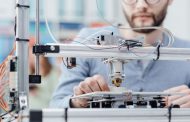The last three years has been rough for the 3D-printing industry. Stratasys (NASDAQ:SSYS), 3D Systems (NYSE:DDD), and ExOne (NASDAQ:XONE) have all fallen far in the last three years. The industry didn’t grow as planned, so all three are still losing 3D printing stock and money. But one company, Proto Labs (NYSE:PRLB) has been spared the worst of the pain and is actually profitable. Understanding why is a good lesson for investors.
The equipment battle that never was
When 3D printers burst on the public scene a few years ago, they were touted as a way to revolutionize manufacturing. Any part could be printed in a short amount of time, making custom manufacturing a relatively easy task, something many thought a lot of companies would take advantage of.
Never mind that 3D printing wasn’t new at all and had been around for decades. Investors saw that 3D printers were becoming smaller and materials were getting better, so the possibilities were endless. Eventually, 3D printing moved from specialized labs and manufacturing shops to desktops as 3D Systems, ExOne, and Stratasys all made products that could be put on a desk in the home. The technology was becoming ubiquitous, but for one small problem.
The missing link was that relatively few people knew how to design parts on computer-aided drafting programs, making the home market extremely difficult to break. And mass manufacturers have little incentive to put the engineering time and money into building custom parts for most products. 3D printing was ready to take off, but no one was there to pilot the plane.
Why Proto Labs is different
What made Proto Labs different is that it wasn’t reliant on customers buying equipment and then refilling material over and over again. The equipment business can be fickle with competitors coming out with new products and consumer demand still an unknown.
Proto Labs took a different approach, serving the engineers who design parts that 3D printers make. But there’s more flexibility with Proto Labs than a single 3D printer, offering more materials and even short production runs. In my personal experience as an engineer who printed hundreds of 3D parts, the end goal was always a production run. So it was valuable to have the path to production in mind.
Serving customers that already had the CAD training necessary to utilize 3D printing and rapid prototyping has been a key for Proto Labs. That eased a major pain point 3D printing companies felt and created a better value case for customers.





